Evolution of the Indian Constitution | IBPS PO Prelims & Mains Preparation - Bank Exams PDF Download
Historical Background
Before 1947, India was divided into two main entities – British India which consisted of 11 provinces, and the Princely states ruled by Indian princes under subsidiary alliance policy. The two entities merged together to form the Indian Union, but many of the legacy systems in British India is followed even now.
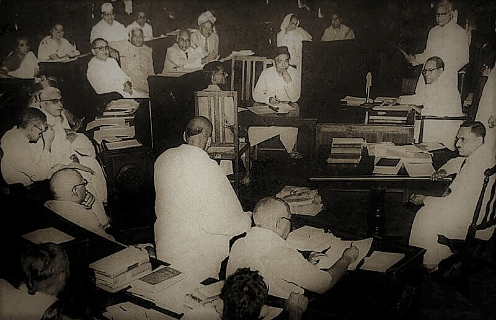 The historical underpinnings and evolution of the Indian Constitution can be traced to many regulations and acts passed before Indian Independence.
The historical underpinnings and evolution of the Indian Constitution can be traced to many regulations and acts passed before Indian Independence.
Constitutional Development
Regulating Act of 1773
- The first step taken by the British Parliament was to control and regulate the affairs of the East India Company in India.
- It designated the Governor of Bengal as the Governor-General (of Bengal).
- Warren Hastings became the first Governor-General of Bengal.
- Executive Council of the Governor-General was established (Four members). There was no separate legislative council.
- It subordinated the Governors of Bombay and Madras to the Governor-General of Bengal.
- The Supreme Court was established at Fort William (Calcutta) as the Apex Court in 1774.
- It prohibited servants of the company from engaging in any private trade or accepting bribes from the natives.
- Court of Directors ( the governing body of the company) should report its revenue.
Amending Act 1781
- Supreme Court to have jurisdiction over all the citizens of Calcutta and to take into consideration religious & social customs.
- For cases involving below £ 5000, the Governor-General in Council was the highest court of appeal.
Pitts India Act, 1784
- Distinguished between commercial and political functions of the company.
- Court of Directors for Commercial functions and Board of Control for political affairs.
- Reduced the strength of the Governor General’s council to three members.
- Placed the Indian affairs under the direct control of the British Government.
- The companies' territories in India were called “the British possession in India”.
- Governor’s councils were established in Madras and Bombay.
The Act of 1786
- Governor-General was made commander-in-chief and was given the power to override his council in extraordinary cases.
The Charter Act of 1793
- The power of the Governor-General to override his Council was extended to all future Governors-general.
- During the absence of Governor-General from Bengal, he was to appoint a vice President from civilian members of the council to act for him.
- All the members in the future to be paid salaries out of the Indian revenue.
- All laws were translated into Indian languages.
Charter Act of 1813
- The monopoly of trade with India was ended but the monopoly of tea trade with China was allowed.
Charter Act of 1833
- The monopoly of tea trade with China was abolished. The company was only to have political functions.
- President of Board of Council became the Minister for Indian affairs.
- A law member without power to vote was added to the Executive Council of Governor-general (Lord Macaulay was 1st law member).
- Competition exams were introduced for recruitment to the coveted services.
- Rs.1 lakh to be spent on education in India.
- It made the Governor-General of Bengal as the Governor-General of India (Lord William Bentinck was the first Governor-General of India).
Charter Act of 1853
- The legislative and executive functions of the Governor-General’s Council were separated.
- 6 members in Central Legislative Council. Four out of six members were appointed by the provisional governments of Madras, Bombay, Bengal, and Agra.
- It introduced a system of open competition as the basis for the recruitment of civil servants of the Company (Indian Civil Service opened for all).
- The British Crown assumed sovereignty over India from the East India Company in 1857 and the British Parliament enacted the first statute for the government of India under the direct rule of the British government.
Government of India Act, 1858
- The rule of the Company was replaced by Crown Rule in India.
- The powers of the British Crown were to be exercised by the Secretary of State for India
- He was assisted by the Council of India, having 15 members
- He was vested with complete authority and control over the Indian administration through the Viceroy as his agent
- The Governor-General was made the Viceroy of India.
- Lord Canning was the first Viceroy of India.
- Abolished Board of Control and Court of Directors.
Government of India Act 1861
- It introduced Indian representation in institutions like the Viceroy’s executive and legislative council (non-official). 3 Indians entered the Legislative Council.
- Legislative Councils were established in the Centre and Provinces.
- It provided that the Viceroy’s Executive Council should have some Indians as non-official members while transacting the legislative businesses.
- It accorded statutory recognition to the portfolio system.
- Initiated the process of decentralization by restoring the legislative powers to the Bombay and the Madras Provinces.
Indian Council Act, 1892
- It introduced the principle of the election but in an indirect manner.
- Though the majority of official members were retained, the nonofficial members of the Indian Constitution council were to be nominated by the Bengal Chamber of commerce and the Provincial Legislative councils while the non - official members of the Provincial Councils were to be nominated by certain local bodies such as universities, district boards, municipalities.
- The councils were to have the powers of discussing the annual statement of revenue and expenditure and of addressing questions to the Executive.
The Minto-Morley Reforms and The Indian Council Act, 1909
- Direct elections to legislative councils; first attempt at introducing a representative and popular element.
- It changed the name of the Central Legislative Council to the Imperial Legislative Council.
- The member of the Central Legislative Council was increased to 60 from 16.
- Introduced a system of communal representation for Muslims by accepting the concept of ‘separate electorate’.
- Indians for the first time in Viceroy's executive council. (Satyendra Prasad Sinha, as the law member)
The Montague- Chelmsford Report and The Government of India Act, 1919
- This Act is also known as the Montague-Chelmsford Reforms.
- The Central subjects were demarcated and separated from those of the Provincial subjects.
- The scheme of dual governance, ‘Dyarchy’, was introduced in the Provincial subjects.
- Under the dyarchy system, the provincial subjects were divided into two parts – transferred and reserved. On reserved subjects, Governor was not responsible to the Legislative council.
- The Act introduced, for the first time, bicameralism at the center.
- Legislative Assembly with 140 members and Legislative Council with 60 members.
- Direct elections.
- The Act also required that the three of the six members of the Viceroy’s Executive Council (other than Commander-in-Chief) were to be Indians.
- Provided for the establishment of the Public Service Commission.
Government of India Act 1935
- The Act provided for the establishment of an All-India Federation consisting of the Provinces and the Princely States as units, though the envisaged federation never came into being.
- Three Lists: The Act divided the powers between the Centre and the units into items of three lists, namely the Federal List, the Provincial List, and the Concurrent List.
- The Federal List for the Centre consisted of 59 items, the Provincial List for the provinces consisted of 54 items, and the Concurrent List for both consisted of 36 items
- The residuary powers were vested with the Governor-General.
- The Act abolished the Dyarchy in the Provinces and introduced ‘Provincial Autonomy’.
- It provided for the adoption of Dyarchy at the Centre.
- Introduced bicameralism in 6 out of 11 Provinces.
- These six Provinces were Assam, Bengal, Bombay, Bihar, Madras, and the United Province.
- Provided for the establishment of Federal Court.
- Abolished the Council of India.
Indian Independence Act, 1947
- Abolition of the Sovereignty and Responsibility of the British Parliament.
- The Crown no longer be a source of authority
- The Governor-general and provincial Governors as constitutional heads.
- Sovereignty of the Dominion Legislature:- The Central legislature of India ceased to exist on 14 August 1947.It was constituent assembly which was to function also as the legislature.
The Making of The Constitution
In 1938, Pandit Nehru formulated his demand for a constituent assembly, which was resisted by the British government until the outbreak of World war –II when external circumstances forced them to realize it.
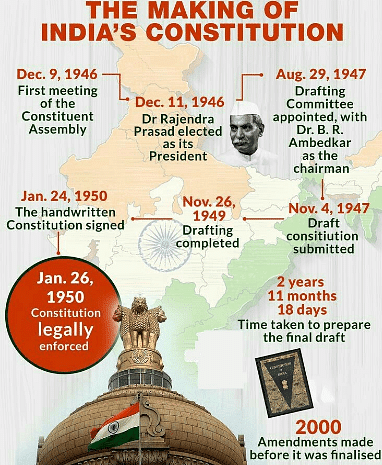
- In March 1942, the British sent Sir Stafford Cripps (Cripps mission) a member of the cabinet with a draft declaration of the proposals of the British government which was to be adopted at the end of the war provided that:
(i) The Constitution of India was to be framed by an elected constituent Assembly of the Indian people.
(ii) India would be given Dominion status.
(iii) There should be one Indian Union comprising all the provinces and Indian states but any province which was not prepared to accept the constitution would be free to retain its constitutional position. - Both Congress and Muslim League rejected it and Muslim League urged that India should be divided into two autonomous states into communal lines and there should be a separate Constituent Assembly to build Pakistan.
- After it, a Cabinet Mission was sent which put forward its proposals on 16 May 1946. The broad features of the scheme were:
(i) There would be a union of India comprising both British India and the States.
(ii) The Union would have an Executive and a Legislature constituted of representatives of the provinces and States.
(iii) The proposal also contained a plan to elect Constituent Assembly by indirect elections, to frame the constitution. - For forming the Constituent Assembly elections were held which were joined by the Muslims League. On 9th December 1946, the first meeting of the Constituent Assembly was held which was not attended by the Muslim League and the assembly began to function without the Muslim members. The Muslim league urged for the dissolution of the constituent assembly on the grounds that it was not fully representative of all sections of the people of India.
- On the other hand, the British government on 20th Feb 1947 declared that British rule in India would in any case end by 30th June 1948.
- Lord Mountbatten succeeded Lord Wavell as Governor-general. He brought the Congress and Muslim league into an agreement that the two problem provinces of Punjab and Bengal would be partitioned to form absolute Hindu and Muslim majority blocks within the provinces which were derived by cabinet mission and the league would get its Pakistan.
- The actual decision of partition of the two provinces was left to the vote of the members of the legislative Assemblies of these provinces. It was also proposed that there would be a referendum in the N.W.F.P and the Muslim-majority districts of Sylhet as to whether they would join India or Pakistan.
- Based on the above plan, the British government passed the Indian Independence Act, of 1947, which provided that from 15 August 1947 in place of India would be set up two independent Dominions to be known as India and Pakistan and gave unlimited power to the constituent assembly of each dominion to frame and adopt any constitution and to repeat any act of the British Parliament including the India Independence Act.
- The Constituent Assembly was reassembled on 14 August 1947 as the sovereign Constituent Assembly of the dominion of India. It had been elected by indirect election by the members of the provincial legislative Assemblies to elect 292 members while the Indian states were allotted a maximum of 93 seats
- As a result of partition under the plan of June 3, 1947, the representatives of Bengal, Punjab, Sind, N.W.F.P, Baluchistan, and Sylhet district of Assam ceased to be members of the Constituent Assembly of India and there was a fresh election in new provinces of West Bengal and East Punjab. So the membership of the House was reduced to 299. Of these 284 were actually present on 26th November 1949 and signed the constitution finally.
[Question: 476132]
Passing of The Constitution
- The Drafting Committee was appointed on 29th August 1947 with B.R Ambedkar as its chairman with six other members which were N.Gopalswami Ayyangar, Alladi Krishnaswamy Ayyar, K.M. Munshi, Mohd. Sadullah, B.L.Mittar (replaced by N.Madhav Rao), D.P.Kaithan (died in 1948 and was replaced by T.T.Krishnamachari).
- The Draft Constitution of India was published in Feb 1948, the assembly next met in Nov. 1948 to consider the provisions of the Draft. On the 26th of November 1949, the constitution received the signature of the President of the Assembly and was declared passed.
- According to Article 394, provisions relating to the citizenship elections, provisional Parliament and temporary and transitional provisions contained in Articles 5, 6, 7, 8, 9, 60,324,366,367,379,380,388,391, 392, and 393 came into force on the day of adoption (i.e. 26 November 1949) of the Constitution and the remaining provisions of the Constitution came into being on the day of the commencement (i.e. 26 January 1950) of the Constitution.
Salient Features of The Indian Constitution
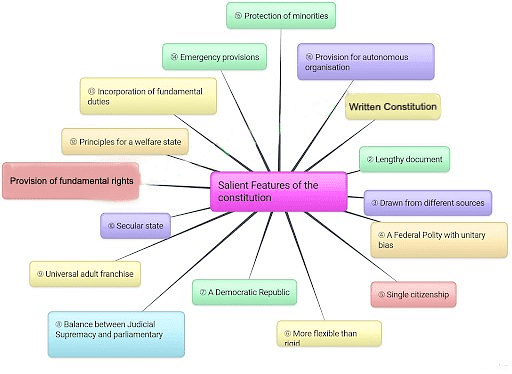
Written, Lengthy and Detailed Constitution
- Written constitution is that which is based on written laws duly passed by a representative body elected for this very purpose. In other words, a written constitution is an enacted constitution.
- An unwritten constitution, on the other hand, is an evolved constitution. It is primarily based on unwritten conventions, traditions and practices. The Constitution of the U.S.A. is another example of a written constitution and that of England of an unwritten one.
- The Constitution of India is an elaborate document and is the most voluminous Constitution in the world. Our Constitution originally consisted of 395 Articles and eight Schedules. During the years of its operation, one hundred and four Amendments have been made to the Constitution. Four new Schedules have also been added, resulting in a further increase in its size and volume.
- An important reason for the extraordinary volume of the Constitution is that it contains detailed provisions regarding numerous aspects of governance. This was done to minimize confusion and ambiguity in the interpretation of the Constitution, another reason for its unusual lengthy is the incorporation of the good points of various constitutions of the world.
- Detailed provisions regarding the working of the Union Government and the State Governments have been given with a view to avoiding any constitutional problem which the newly-born Democratic Republic might experience in the working of the Constitution.
Partly Rigid and Partly Flexible Constitution
- A flexible constitution is that which can be amended like an ordinary law of the country, i.e. by a simple majority of Parliament. On the other hand, a rigid constitution is the one that prescribes a difficult procedure for its own amendment.
- The Constitution of the U.S.A. is the best example of rigid constitution because it can be amended only if a proposal for constitutional amendment is passed by a two-third majority in each House of the Congress (the US Parliament) and ratified by at least three-fourths of the federating states.
- The Constitution of Great Britain, on the other hand, is highly flexible. This is so because it can be amended by a simple majority of its Parliament, much like the ordinary laws of the country.
- The Indian Constitution is neither very flexible nor very rigid. Some provisions of the Constitution can be amended by a simple majority of Parliament, like ordinary laws of the land while most of the provisions can only be amended by a two-thirds majority of Parliament.
- For very important provisions of the Constitution, such as the manner of election of the President and the extent of the legislative powers of the Union and the States, an amendment passed by a two-thirds majority of Parliament should also be ratified by at least one-half of the State legislatures.
- The Indian Constitution thus combines the flexibility of the British Constitution and the rigidity of the American Constitution. Jawaharlal Nehru, while justifying this nature of the Constitution, said, "Our Constitution is to be as solid and permanent as we can make it, yet there is no permanence in a constitution. There should be a certain amount of flexibility. If you make anything rigid and permanent, you stop the nation's growth, the growth of a living vital organic people."
Partly Federal and Partly Unitary
- Our Constitution declares India a Union of States (federation). It prescribes a dual set of governments-the Union Government and the State Governments.
- The subjects of administration have also been classified into three lists-the Union List, the State List and the Concurrent List. Whereas subjects of national importance like currency, defense, railways, post and telegraph, foreign affairs, citizenship, survey and census have been assigned to the Union Government and placed under the Union List.
- Subjects of local importance like agriculture, law and order, health and entertainment have been assigned to the States and form a part of the State List.
- Both the Union Government and the State Governments operate within the spheres of their authority. The Union Parliament and the State Legislatures enjoy co-equal powers to make laws in regard to the Concurrent subjects. These subjects are of common importance such as marriage and divorce, adoption, succession, transfer of property, preventive detention, education, civil and criminal law, etc.
- However, if there is a conflict between a Union law and a law passed by one or many State Legislatures, the law made by the Union Parliament would prevail over the State law.
- The Indian Constitution possesses other features of a federation too, for example, supremacy of the constitution. This means that the Union and the State Governments both operate within the limits set by the Constitution. Both the governments derive authority from the Constitution itself.
- Similarly, in all federal countries, the authority of the Court is a well established fact. This means that in case of a dispute between the Union Government and State Governments or between two or more State Governments, the verdict of the Court will be final. Not only this, the Supreme Court is given the responsibility of interpreting the Constitution in case of dispute or confusion. The Supreme Court of India is the guardian of the Constitution and fulfils its role as a Federal Court too.
- The Indian Constitution, though federal in form, has a strong unitary bias. The Central Government possesses extensive powers compared to the State Governments. The exercise of these powers by the Centre gives the Constitution the strength of a unitary government. Let us look at those provisions of the Indian Constitution that make it partly unitary. The Union Government can supersede the authority of the States both in the normal and abnormal times. The President of India can declare three different types of emergencies. During the operation of an emergency, the powers of the State Governments are greatly curtailed and the Union Government becomes all in all.
- Even in normal times, the Union Parliament can legislate upon a subject given in the State List, if the Rajya Sabha passes a resolution by a two-thirds vote that such legislation is necessary in the national interest.
- Moreover, the Indian Constitution, unlike the US Constitution, does not provide for double citizenship, division of public services or of the judiciary.
- Similarly, the States in India do not enjoy the right to secede from the Union nor do they enjoy equality of representation in the Council of States (Rajya Sabha).
- Another unitary feature of our Constitution is that it gives Union Parliament the power to alter the boundaries of the existing States or to carve out new States out of the existing ones. It is on account of these features that the Indian Constitution is said to be federal in form but unitary in spirit.
Influence of Other Constitutions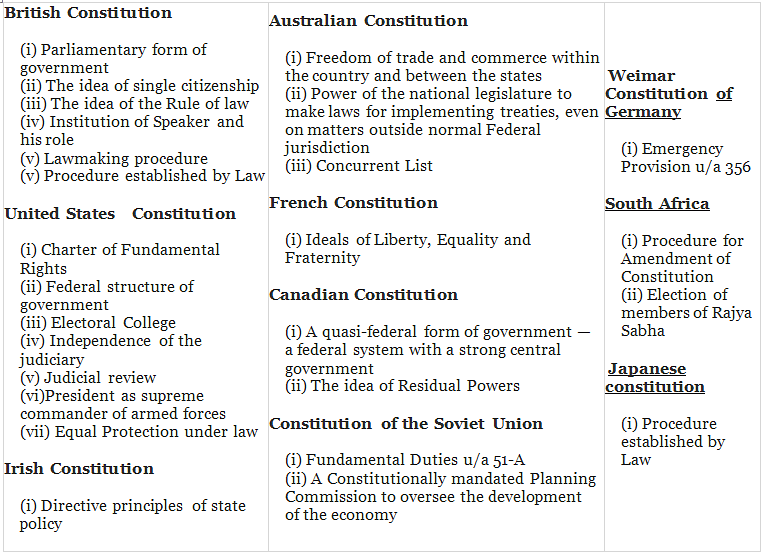
The salient feature of the constitution → Borrowed country
The Preamble
- The Preamble to the Constitution sets out the main objectives which the Constituent Assembly intended to achieve.
- The 'Objective Resolution', proposed by Pandit Nehru and passed by the Constituent Assembly, ultimately became the Preamble to the Constitution of India.
- The Constitution (42nd Amendment) Act, 1976 amended the Preamble and added the words Socialist, Secular, and Integrity to the Preamble.
- The Preamble is non-justiciable in nature, like the Directive Principles of State Policy, and cannot be enforced in a court of law.
- It can neither provide substantive power (definite and real power) to the three organs of the State, nor limit their powers under the provisions of the Constitution.
- The Preamble cannot override the specific provisions of the Constitution. In case of any conflict between the two, the latter shall prevail. So, it has a very limited role to play.
Purposes of the Preamble
- The Preamble declares that it is the people of India who had enacted, adopted, and given the Constitution to themselves. Thus, sovereignty lies ultimately with the people.
- It also declares the ideals and aspirations of the people that need to be achieved.
The Preamble
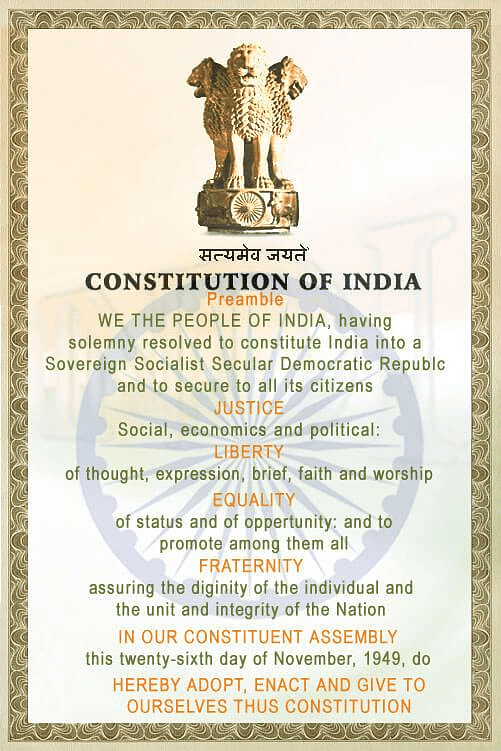
Sovereign
- The word 'Sovereign' emphasizes that there is no authority outside India on which the country is in any way dependent.
Socialist
- By the word 'Socialist', the Constitution means the achievement of a socialistic pattern of society through democratic means.
Secular
- India is a 'Secular State' does not mean that India is non-religious or irreligious, or anti-religious, but simply that the State in itself is not religious and follows the ancient Indian principle of "Sarva Dharma Samabhava".
- It also means that the State shall not discriminate against the citizens in any way on the basis of religion.
Is it a part of the Constitution?
- The Supreme Court in the Kesavananda Bharati vs. State of Kerala (1971) case overruled its earlier decision (Berubari case) of 1960 and made it clear that it is a part of the Constitution and is subject to the amending power of the Parliament as any other provisions of the Constitution, provided the basic structure of the Constitution as found in the Preamble is not destroyed. However, it is not an essential part of the Constitution.
- In the latest S.R. Bommai case, 1993 regarding the dismissal of three BJP Governments in MP, Rajasthan and Himachal Pradesh, Justice Ramaswamy said, "the Preamble of the Constitution is an integral part of the Constitution. A democratic form of government, federal structure, unity, and integrity of the nation, secularism, socialism, social justice, and judicial review are basic features of the Constitution".
- The question arises as to why Preamble was amended when it is a basic feature. By the 42nd amendment, the Preamble was amended to include 'socialist',' secular', and 'integrity' as it was assumed that these amendments are clarifying and qualifying in nature. They are already implicit in the Preamble.
Democratic
- The term 'Democratic' means that the rulers are elected by the people, and they only have the authority to run the government.
Republic
- The word 'Republic' means that there exists no hereditary ruler in India and all the Authorities of the State are directly or indirectly elected by the people.
The Preamble states that the objectives to be secured to every citizen are
Justice: social, economic, and political
- Regarding justice, one thing is clear that the Indian Constitution expects political justice to be the means to achieve social and economic justice, by making the State more and more welfare-oriented in nature.
- Political justice in India is guaranteed by universal adult suffrage without any sort of qualification.
- While social justice is ensured by abolishing any title of honor (Art. 18)
and untouchability (Art. 17), economic justice is guaranteed primarily through the Directive Principles.
Liberty: of thought, expression, belief, faith, and worship
- Liberty is an essential attribute of a free society that helps in the fullest development of the intellectual, mental, and spiritual faculties of an individual.
- The Indian Constitution guarantees six democratic freedoms to individuals under Art 19 and the Right to freedom of religion under Arts 25-28.
Equality: of status, opportunity
- The fruits of liberty cannot be fully realized until there is an equality of status and opportunity.
- Our Constitution makes it illegal, any discrimination by the State only on the basis of religion, caste, sex, or place of birth (Art. 15) by throwing open public places to all, by abolishing untouchability (Art. 17) and by abolishing titles of honor (Art 18).
- However, to bring the hitherto neglected sections of the society into the national mainstream, the Parliament has passed certain laws for the SCs, STs, OBCs (Protective Discrimination).
Fraternity
- Fraternity as enshrined in the Constitution means a sense of brotherhood prevailing amongst all the sections of the people. This is sought to be achieved by making the State secular, guaranteeing fundamental and other rights equally to people of all sections, and protecting their interests. However, fraternity is an evolving process and by the 42nd amendment, the word 'integrity' was added, thus giving it a broader meaning.
- KM Munshi termed it as 'the Political Horoscope'. Earnest Barker calls it the 'key to the Constitution'. Thakurdas Bhargava recognized it as the 'Soul of the Constitution'.
- The term 'Socialistic pattern of society' was adopted as a goal of the Indian State by the Congress in 1955 in Avadi Session.
Composition
Indian constitution consists of 22 parts, 395 articles, and 12 Schedules (initially 8 schedules were there) which are as follow:
Parts of the constitution
- Part I - Union and its Territory
- Part II - Citizenship.
- Part III - Fundamental Rights.
- Part IV - Directive Principles and Fundamental Duties.
- Part V - The Union.
- Part VI - The States.
- Part VII - States in the B part of the First schedule.
- Part VIII - The Union Territories
- Part IX - Panchayat system and Municipalities.
- Part X - The scheduled and Tribal Areas
- Part XI - Relations between the Union and the States.
- Part XII - Finance, Property, Contracts, and Suits
- Part XIII - Trade and Commerce within the territory of India
- Part XIV - Services Under the Union, the States, and Tribunals
- Part XV - Elections
- Part XVI - Special Provisions Relating to certain Classes.
- Part XVII - Languages
- Part XVIII - Emergency Provisions
- Part XIX - Miscellaneous
- Part XX - Amendment of the Constitution
- Part XXI - Temporary, Transitional and Special Provisions
- Part XXII Short title, date of commencement, Authoritative text in Hindi, and Repeals.
Schedules
There are 12 Schedules in the Indian Constitution. Schedules can be added to the constitution by amendment.
- States and Union Territories;
- Emoluments for High-Level Officials;
- relates to different forms of Oaths;
- Allocation of the number of seats in the Rajya Sabha (Council of States - the upper house of Parliament) per State or Union Territory;
- Provisions for the administration and control of Scheduled Areas and Scheduled Tribes;
- Provisions for the administration of tribal areas in Assam, Meghalaya, Tripura, and Mizoram;
- Relates to three types of lists: The Union (central government), State, and Concurrent (dual) lists;
- The Official Languages Recognised under the constitution ( There are 22 languages in this schedule; English is not mentioned in this schedule).
- Article 31B-Validity excluded from Court’s Review (land and tenure reforms; the association of Sikkim with India). It was added by the 1st Constitution Amendment Act in 1951. It is the largest schedule of the constitution.
- Anti-Defection provisions for Members of Parliament and Members of the State Legislatures (added by 52nd Constitution Amendment Act in 1985).
- It relates to functions of Panchayats (Rural Development); added by the 73rd Constitution Amendment Act in 1992.
- It relates to functions of Municipalities (Urban Planning); added by Constitution Amendment Act in 1992.
|
536 videos|683 docs|263 tests
|
FAQs on Evolution of the Indian Constitution - IBPS PO Prelims & Mains Preparation - Bank Exams
| 1. What is the historical background of the Indian Constitution? |  |
| 2. What were the key stages in the constitutional development of India? |  |
| 3. What were the major influences in the making of the Indian Constitution? |  |
| 4. What are the salient features of the Indian Constitution? |  |
| 5. What is the significance of the Preamble in the Indian Constitution? |  |
|
536 videos|683 docs|263 tests
|

|
Explore Courses for Bank Exams exam
|

|


















